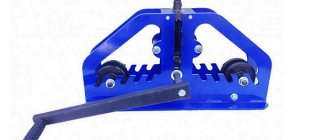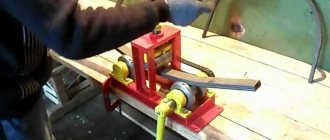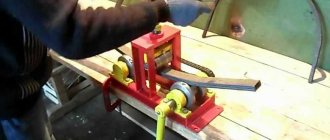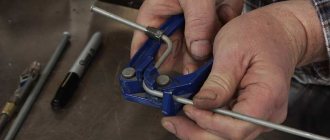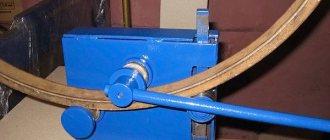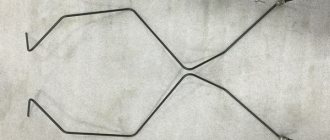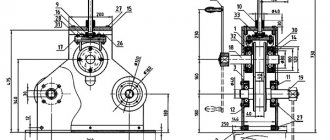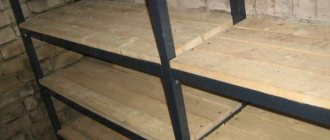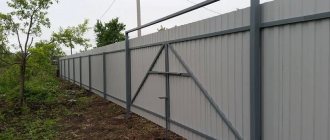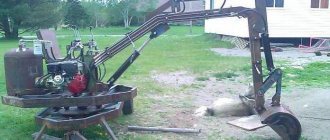When arranging a site or preparing for the dacha season, the need arises for arches made of profile pipes. They are needed when constructing a greenhouse, assembling a gazebo or canopy. It is expensive to buy already bent arches - the price is twice as high as for the same flat rolled products. The solution is to do it yourself, and to make the process easier (it’s very difficult to do by hand) you need to make a pipe bender for the profile pipe. You will need channels or corners, rolling rollers and some other details. Tools include a grinder with a metal disc, a welding machine, and a ruler.
Profile bender design
The machine for bending profile pipes is structurally different from the usual one. This is due, firstly, to the greater resistance of the profile to bending loads, and secondly, to the fact that the bending radius usually required is large. Therefore, the design contains three rollers. Two of them are installed permanently, one remains movable. Using a movable roller, the radius of curvature changes. In general, there are two types of pipe benders for profile pipes: with a middle movable roller and with an outer one (right or left, as desired).
You can make a pipe bender for a profile pipe in different sizes with your own hands
Pipe bender with middle movable roller
The two outermost rollers are fixedly mounted on the body. They are raised above the plane of the base. For the middle roller, a special U-shaped frame is welded. A long, large-diameter clamping screw is installed in the middle of its jumper. A third bead is attached to the lower end of this screw (can be welded). By rotating this screw, the roller lowers and rises, changing the bending radius of the profile pipe.
Design of a pipe bender for a profile pipe with a movable middle roller
A cloud is welded to one of the stationary rollers, with the help of which the pipe is rolled through the machine. To make it possible to apply less effort for rolling, two stationary rollers are connected using a chain. To effectively transmit torque, sprockets are welded to the rollers (possibly from a bicycle), and a chain is selected for them. This simple mechanism makes bending a profile pipe much easier.
With extreme movable roller
In this design, the right or left roller is made movable. It moves along with part of the base. This part is connected to the rest of the frame using powerful metal hinges.
Drawing of a bending machine for profile pipes with a lifting platform
You can change the height using a jack, as shown in the drawing. The height of the platform in this case is selected depending on the height of the jack. The bending radius is changed by lifting the movable part of the table.
Pipe bender for profile pipe with lifting platform
Unlike the previous design, this pipe bender for a profile pipe is driven from the central roller - a handle is welded to it. To reduce the required force, you can also weld the sprocket to two fixed rollers and transmit torque using a chain.
Design and principle of operation of an electric pipe bender
The main load when operating a pipe bender with an electric drive falls on the powerful engine. It is he who transfers the rotational load to the bending element. Various attachments are put on the rotor, the shape of which depends on the expected result.
In addition, the structure of the pipe bender includes the following parts:
- frame;
- clamping devices;
- fastenings;
- control panel.
If it's a cheaper option for regular users, it will usually have setup buttons and a control panel. On industrial machines of this type, displays are installed, with the help of which settings are made.
The main functions of the clamps are:
- reliable fixation of the workpiece;
- protecting the employee from possible injuries.
Fasteners also serve to hold the bent element in the position required for operation.
What materials and design details are needed?
The base of the pipe bender is made from a channel or two welded angles. The thickness of the shelves is at least 3 mm; select the width of the shelves and the back of the channel to match the existing parts. One rule - the base must be massive and reliable.
Several holes can be made along the edges of the platform. Through them you can fix the machine to some heavy base using large diameter self-tapping screws. Fixation is necessary, since when bending pipes with a thick wall, significant forces have to be applied and it is more convenient to work if the machine is firmly fixed.
This is what the frame looks like with welded racks for attaching the movable roller
A few words about rollers. They must be made of good, high-quality, preferably hardened steel. It is on the rollers and on the axles that hold them that most of the load falls.
It should also be said about the shape of the rollers. They should not be smooth - there should be rollers along the edges that will prevent the pipe from “walking” during rolling. Only under such conditions will the arc from the profile pipe be smooth and not twisted. Ideally, each pipe size needs its own rollers. But then the design becomes more complicated - they need to be made removable, and a reliable method of fastening must be thought out. The second option is to make videos of complex shapes, such as in the photo. Carve several steps for different pipe sizes.
Rollers for bending profile pipes of different widths
In the same photo you can see that the upper part of the bed is not smooth, but toothed. With the help of such teeth, the rollers can be rearranged to different distances and thus also adjust the bending radius.
In general, homemade bending machines for profile pipes are assembled from what is at hand or what they can find/buy inexpensively. Those who have the opportunity grind out the rollers and insert bearings. Those who don’t have such an opportunity use what they have, right down to the bushings from bicycle wheels. In general, you need to understand the design and
Making a lever pipe bender
A selection of photographs and drawings for making a lever-type pipe bender yourself, as well as a video with comments and explanations from the author.
This lever pipe bender is not too difficult to manufacture and allows you to work with fairly thick pipes
A video from the author will allow you to understand the key points and small nuances of manufacturing this pipe bender.
Tricks to make pipe bending easier
To make the rollers move better, bearings are used. But, in principle, for a homemade pipe bender, which will be used only occasionally, you can simply make holders from a corner or channel. Make a hole in them that is slightly larger in size than the axis on which the roller will be mounted. Pass the axle with the roller on through the holes of the holders and somehow fix them (at least weld on a couple of points that will be stoppers). During operation, for better performance, lubricate the rubbing areas with a thick lubricant such as Litol. This is not suitable for industrial and semi-industrial production, but it’s just right for making arcs for a greenhouse or gazebo with your own hands.
Example of turned beads
There is one more trick that helps reduce the required force when bending a profile pipe. You can use the principle of increasing gears as in a bicycle. By the way, you can use bicycle sprockets. In this case, the handle that drives the rollers is welded to a small star. It is installed somewhere on the body. Larger sprockets are welded onto the shaft axis (but teeth with the same pitch). All this is connected by a suitable chain.
With such a torque transmission device, an electric drive is not needed - it will be easy to work
And one more improvement - if you constantly use a pipe bender for a profile pipe, it makes sense to mechanize it. In this case, they install a motor that operates at low speeds.
Operating rules
When using the mechanism, do not allow it to fall or be struck.- Be sure to protect it from moisture and precipitation.
- During operation, all its rotating elements must be closed or at least located at a safe distance from others.
- Make sure that fingers, clothing, and foreign objects do not get between the shafts.
Do-it-yourself home pipe bender for a profile pipe: photos of self-made models
The procedure for bending a profile pipe on homemade machines
It is unlikely that you will be able to obtain the required bending radius in one go - too much force is required for this. It is impossible to create it manually. Receive the required bend in several passes:
- First, the rollers are aligned so as to obtain a slight bend, the pipe is rolled in one direction, then removed from the rolls, unfolded and inserted on the other side. It is necessary to unfold in order to obtain an evenly curved pipe.
- With the same position of the rollers, it is pulled several times until the curvature is no longer added.
- If the required bending radius is not achieved, change the position of the roller and repeat the steps again.
Rolling pipe bender with electric drive
The change in bending radius is achieved gradually, otherwise you won’t be able to make an arc from a profile pipe on a homemade pipe bender. What to do if you need to repeat the same bend? Make a graduation - note to what height the roller moved, how many times it was rolled in each position. When repeated, the differences, if any, will be insignificant.
The difficulty of bending lies in the fact that there is no scale and it is difficult to obtain the intended bending radius without experience. Sooner or later you will get it, but you can spoil a lot of material in the process.
How to make a profile pipe bender with your own hands, working according to a template
In this case, the guide elements are boards, the cross-section of which should be a couple of centimeters larger than that of rolled products.
- Securely fasten the selected wooden products to a durable metal base that can withstand even significant loads.
- Place a stop nearby on which the bent parts will subsequently be placed.
- Connect the winch so that you don’t have to make physical efforts when making the passage.
With this version of the device, it is not necessary to saw the boards to create bevels, gutter or slope, and this has a positive effect on the overall durability of the configuration. But limiters are needed in any case - so that the element being processed does not move out. It must be carefully inserted into the gap between the template and the stop, then gently press on its free end, setting the initial clamping force.
This option is good for its ease of implementation, but it does not always guarantee the accuracy of the curvature - the final radius may be several degrees less than required. Well, the guides are not universal - in fact, they are only suitable for one diameter. Therefore, it makes sense to look for other solutions.
“Snail”: we’ll make this rolling pipe bender with our own hands, with a drawing and diagrams
So named because of the specific shape of the spiral.
This machine is good for stamping large quantities of the same type of blanks. Even in the rack version, its dimensions are relatively small, so placing it on site is not a problem (even if it is a small home workshop). It's also easy to operate. Manufacturing takes place in several stages:
- You make the center - cut off a piece of round timber with a diameter of 38 mm and a thickness of 28 mm, and drill an eccentric hole of 8 mm in it. Using a grinder, remove excess metal to form a voluminous petal. After that, punch out a new seat on its radial surface - for an M10 thread.
- You form a spiral - from a steel strip 4 mm thick, according to the design, with such a shape of turns that you can subsequently provide any desired radius of curvature.
- Cut out the support plate - from a carbide sheet, 3 mm, not narrower, since it must withstand significant loads. Weld it to it.
- Attach the resulting functional unit to a metal stand that is strong enough, with a wall thickness of 3 mm or more. Fix it with bolts screwed into pre-drilled holes for this purpose.
- Weld the handle - on the reverse side, so that in the future it will be easier for you to remove and install the parts being processed.
The only disadvantage of the resulting mechanism is that it provides only small radii of curvature. If you try to greatly bend the workpiece on it, there is a chance that you will simply break it off.
Rental devices
At their core, these are also simple machines that create flexible pipes at any desired angle.
Their peculiarity is that the profile completely passes through their entire structure (hence the name). Otherwise, they do not differ from the standard ones: there is a base and shafts, with the driving ones providing broaching, and the movable one providing pressing force. And then, by the way, it’s time to look at what such equipment generally consists of.
How to bend a profile pipe without a machine
There are two ways to make an arc from a profile pipe without a profile bender - using welding and a template. Let's start with welding.
Get an arc by welding
The profile pipe is cut with a grinder on one side. They are made every 15-30 cm, depending on the required radius, cross-section and wall thickness. The cuts should not touch one side - the one that will be on the outside.
Result of bending by welding
The spare part prepared in this way is bent, giving the desired bend. For reliability, the edges of the arc can be fixed by welding a rod to them. Then welding is carried out along all the cuts, welding them. And the last stage is grinding the weld spots and treating them with anti-corrosion compounds.
Using a template
Thin-walled profiled pipes can be bent by hand using templates. If you need a special shape, it can be cut out of a piece of thick plywood or chipboard and secured to the table using clamps. On the workbench where we will bend the pipes, make about 8-10 holes. The template is placed near these holes.
The process of obtaining an arc from a profile pipe using a template
The holes are repeated at one end of the pipe; with their help, the pipe is attached to the workbench. Now the free end of the pipe begins to be pulled smoothly, forming a bend that follows the shape. You need to pull smoothly, without jerking.
The template can also be made on the ground. Pipes-pegs are driven into the ground (at least half a meter deep). They form the required arc. For emphasis, two additional stakes are driven in, which are located to the side of the arc. The distance you need to step aside is slightly greater than the width of the pipe.
Pattern on the ground
Having inserted the pipe, it is pulled towards the arc. Great efforts are required, the work is hard. This can only be achieved with a thin-walled, seamless pipe. The suture has too much resistance in the seam area. It is very difficult to overcome it manually.
Stationary pipe benders
For stationary equipment, a separate space is required, since they are large in weight and size. These ET models have a strong, large frame that supports a fairly powerful engine.
Such devices can work with pipe products of all types and sizes. In particular, they can process profiled steel pipes with thin walls, products with a large cross-section and thick walls, used in high-pressure water mains.
Compared to stationary devices, handheld ETs have more limited capabilities, although they can still be very useful for their purposes.
Why do you need to bend pipes with a pipe bender?
Metal collectors can be bent in a simple mechanical way, having first secured one end of the tube, using gas welding, or other methods.
But in order to give a thin-walled steel or metal-plastic pipe the required shape of the highest quality, it is best to use a homemade pipe bender.
Using this method, the product will bend very well and its structure will be completely preserved.
The use of a pipe bender is due to:
- the least risk of unnecessary pipe deformation;
- ease of use;
- the ability to work with risers of any diameter;
- complete safety when working with the device.
Plus, there is no need to waste time and money heating the product, the number of joints (welded or threaded) is reduced, and the design of the line will be more reliable and impact-resistant.
When installing a pipeline, use a manual, hydraulic or electric pipe bender (ET). Today, the last option, which you can do yourself, is considered the most popular.
Drive types
Bending machines may differ in the type of drive. For example, the most budget options are with mechanical drive.
That is, in this case, all the work of bending a round pipe is done with the strength of your own hands. A long lever is used to increase the applied force.
In some cases, a mechanical car jack can act as a mechanical drive (for example, in homemade crossbow-type pipe benders).
There are also more practical designs of bending machines that use an electric or hydraulic drive. This makes it much easier to work with workpieces, in particular bending pipes with your own hands.
Hydraulic pipe bender
There can be a lot of options for such machines. But we will look at the most accessible and simple ones. We advise you to read a detailed description of how to assemble a tabletop pipe bender from a car bottle jack.
The basis of this design is a frame welded from profile pipes (other materials can also be used).
A car jack is attached to the upper part of the frame, and a template (or stamp) with a groove for pipes of a suitable diameter is attached to the lower part.
Using a self-made pipe bender in the garage and workshop for bending pipes, you can bend metal pipes of different diameters: ¾ inch, ½ inch, 1 inch. In this case, the workpiece bends evenly, without flattening or deforming.
You can find out the detailed manufacturing process, how the homemade product works and its dimensions by reading the review article at the link above.
Electrically driven
Such designs, although not as popular as hydraulic bending machines, are still used. We talk about one of the options for this pipe bender in an article with a photo and video review.
The device frame can be made from scrap metal that you have in your workshop. An electric motor with a gearbox is used as a drive.
Sections of steel round timber processed on a lathe are used as rolling shafts for profile pipes. The design is excellent for bending arcs and half-arches from long workpieces.
If you do not have the opportunity to make a bending machine for pipes with an electric or hydraulic drive, then you can make a manual pipe bender with your own hands.
Of course, it is not as functional as its more advanced “brothers,” but it is quite suitable for working with small workpieces (but mainly for bending metal pipes with thin walls).
It is much easier to assemble, and no drawings are needed. You can see from the photographs what's what.
Manual pipe bender pros and cons
If we consider the main advantages of the design, then, first of all, it is worth noting the simplicity and low cost of its manufacture (after all, many components can be obtained at a metal receiving station).
As a rule, the simplest manual pipe benders differ from other machines in their light weight and quite compact size, which makes these devices mobile and transportable. And they are very convenient at home.
This mini machine can work with thin-walled steel pipes and aluminum pipes. Pipe bender diagrams can be downloaded for free on the Internet.
But if it is necessary to bend thick-walled pipe products, then a hand-made pipe bender is unlikely to be useful.
